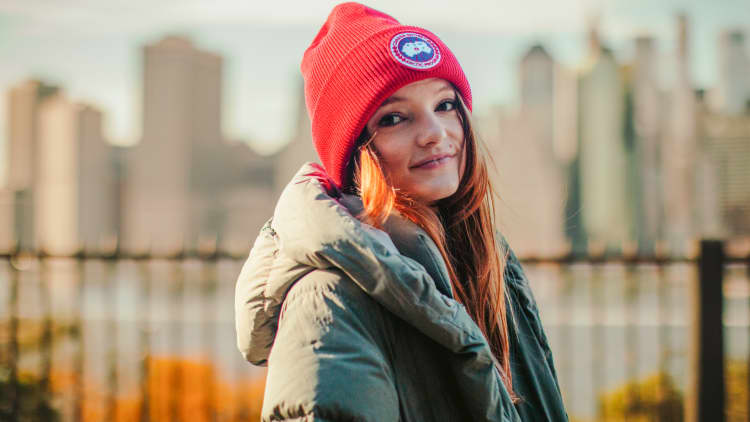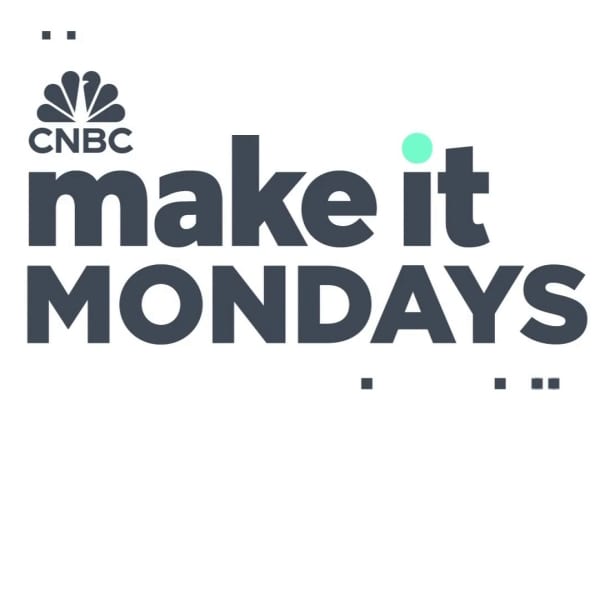When Dani Reiss took the reins as CEO of Canada Goose, he was a 27-year-old running a company that brought in a couple million dollars per year in revenue.
Today, the 50-year-old presides over a global brand worth $1.13 billion in U.S. dollars — something his maternal grandfather likely could've never imagined upon launching the company with five sewing machines in a small Canadian factory in 1957.
Canada Goose parkas, which can cost upwards of $1,900, are sported by Oscar winners, Olympians and Arctic explorers. In its most recent fiscal year, the company brought in $878.47 million in revenue, and by Reiss's estimation, sold "well over a million jackets."
That includes a rough six-month stretch for the luxury sportswear company, which saw its stock price hit an all-time low of $9.80 per share during the day on November 1. Uncertain economic conditions, tighter consumer spending and unusually high temperatures have contributed to the drop, according to a Wells Fargo research note published last month.
Yet Reiss, perhaps predictably, remains publicly confident — because wearing Canada Goose carries cultural value, he tells CNBC Make It.
"You look at luxury brands in the world [and] they make things at home," he says. "When you buy a Canada Goose jacket, you're buying a piece of Canada. That's important. You can't replace that."
Here's how Canada Goose began, grew to billion-dollar status and plans to survive consumer uncertainty.
Building a homegrown Canadian brand
When Reiss's grandfather Sam Tick started the company, it was called Metro Sportswear Ltd. Tick, an immigrant from Poland, sold wool vests, raincoats and snowmobile suits. His store only had a handful of sewers on staff, Reiss estimates.
The company mostly functioned as a private label, designing coats for businesses that would become its competitors, like L.L. Bean and Eddie Bauer, says a Canada Goose spokesperson.
Reiss's father, David Reiss, took over in the 1970s. He invented a down-filling machine, which dramatically cut down on production time, and rebranded the business to Snow Goose. He also created the company's iconic red Expedition Parka, initially meant for scientists at Antarctica's McMurdo Station.
Growing up, Reiss had no interest in joining the family business, he says. He hated clothing brands that advertised themselves on clothing, cutting alligator logos off Lacoste polo shirts. He did work odd jobs at his dad's office to earn pocket cash, filling jackets, shipping coats and working as a janitor and receptionist.
After graduating from the University of Toronto with an English literature degree in 1997, Reiss wanted to travel around Europe and Asia — but didn't have any money. He returned to Snow Goose, planning to collect three months of paychecks before jetting off.
This time, he worked in sales, and speaking with customers made him finally realize that luxury coats weren't just pretentious status symbols, he says. Some customers, especially in the country's north, actually needed high-end gear to stay warm. The jackets enabled people "to live their lives," says Reiss.
After a year, he decided to stay permanently.
Getting ahead of the competition
When Reiss became CEO three years later, his first goal was to shift the business model away from its private label origins. That meant another rebrand, to appear more public-facing. Reiss chose the name Canada Goose to indicate quality, because the coats were manufactured on home turf, he says.
It also necessitated some new marketing. One of Reiss's most successful efforts, by his estimation, was the Canada Goose Cup. In 2010, the brand hosted a ball hockey tournament, challenging its retail competitors to put together teams of employees and compete.
The entry fee: $300 per team, with all proceeds donated to The Conservation Alliance, an environmental group. Even though Canada Goose lost its own tournament, the trophy — sporting the company's red, black and white logo — still sat in the lobby of the winner's headquarters, Reiss says.
In 2013, Canada Goose inked an investment deal with Bain Capital for an undisclosed amount, in exchange for a majority stake of the company. The funding helped propel the brand into physical spaces, including flagship stores in Toronto and New York that opened in 2016.
A year later, Canada Goose went public, opening on the New York Stock Exchange at $18 per share. At the time, Reiss owned 30% of the company, according to a public filing.
The stock took off, rising as high as $70.05 per share at the end of the day on November 16, 2018. Reiss still owns more than 10% of the company today, he says.
Holding on to profit and relevance
Canada Goose's challenges started well before the current stock dip. When it went public, for example, the nonprofit People for the Ethical Treatment of Animals bought 230 shares of its stock, enough to submit a letter to shareholders and attend its annual meeting.
The company stopped using fur in its products four years later, only selling the extant fur-based items left in its inventory.
"We realized that we could make jackets that are just as good without fur as with fur," Reiss says. "We may as well do that and just make the jackets more sustainable ... In the marketplace today, you don't see a lot of jackets with fur from anybody."
But while Canada Goose's stock may be down, the business has pulled ahead of competitors since going public. Its annual revenue has roughly doubled since its 2018 fiscal year, financial disclosures show. In comparison, global sales of winter clothing grew at a compound rate of just 3.5% between 2018 and 2022, according to a Future Market Insights industry report.
Canada Goose remains profitable, too: After expenses, it made $83.3 million in adjusted net income last fiscal year. Reiss plans to keep it that way by opening new stores, creating new product lines and growing brand awareness in the U.S. and China, he says.
What's non-negotiable, he adds, is the high-quality manufacturing that helped Canada Goose gain its international value in fashion, entertainment and pop culture.
"[People] don't want some product that has lots of marketing behind it, that's flashy and is trendy," Reiss says. "They want something that's real and that's classic and that's going to stand the test of time. I think that's why we've been so successful, because we make the best-in-class product."
Conversions from CAD to USD were done using the OANDA conversion rate of 1 CAD to 0.72183 USD on November 1, 2023. All amounts are rounded to the nearest dollar.
DON'T MISS: Want to be smarter and more successful with your money, work & life? Sign up for our new newsletter!
Get CNBC's free Warren Buffett Guide to Investing, which distills the billionaire's No. 1 best piece of advice for regular investors, do's and don'ts, and three key investing principles into a clear and simple guidebook.








